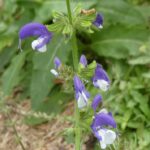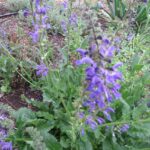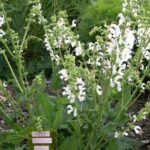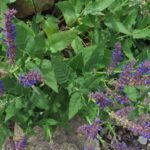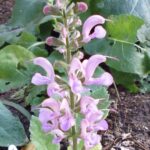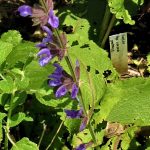Salvia pratensis hybrids: These are herbaceous perennials approx 40-60cmH, large leaves in a rosette clump with spires of either mauve, pale pink, purple or white flowers in late spring and summer.

Salvia pratensis hybrids: are similar to the Salvia nemorosa hybrids but very different in height and the inflorescence formation.
Varieties that we know of that are accepted hybrids: Some older named varieties have been either lost or have not been accepted as a pratensis hybrid.
S.pratensis – this is very variable, depending the age of the variety
‘Haematodes’
‘Verona’ spp
‘Skydance’
‘Swan Lake’
‘Madeline’
‘Indigo’
‘Sweet Esmeralda’
S.kuznetzovii
These are all described separately: please see A-Z pages
Pratensis :
- Basal leaf growth: producing a leafy clump before and during flowering.
- Stems: are branched, mainly green 60-80cmH. Most stems are bare, with one or two small triangular leaves along stems. Depending on the age of the plant quite a few stems can be produced per clump.
- Leaves: are large, broad, lanceolate, with long petioles and a very pointed tip. Most are a mid green or a rich deep colour. Only a few small triangular leaves are found beneath the branching stems and first flowers.
Flowers: are large, a falcate type flower with a large space between the hood and the lower lobes, which opens up the throat area for insect access. Most have some markings on the bottom lobe around the throat to guide bees and pollinating insects to explore further into the flower.
Flowers are in whorls, regularly positioned along the flower stem with the top flowers often open at the same time as the bottom opened flowers. The flower heads could be as long as 20cmL. All flower stems are held well above the foliage to attract any passing bees and insects.
- Flowering time: coming into flower quickly, flowering from mid spring October & November until early summer – December / January/ February
- Colours: include mauves, purples, pinks and whites.
Salvia pratensis hybrids: can form spectacular centre pieces to a garden bed. They can add height and drama to a bed with all the flower stems which can be a froth of colour for a few weeks in early summer and again a mass of stems full of seed at the end of the season. This mass of flower stems is very attractive to bees and pollinating insects.
Grow in a full sun position with other small shrubs and perennials. Plant in groups of 3-5 plants which will certainly make a statement when they begin to flower. They look especially good in a mixed border with similar coloured perennials. They are very attractive, holding their flower stems well above other plants high enough to attract passing bees and insects.
Not fussy about the soil, so long as it’s well drained. Once established, they are tough and hardy for the summer months and with the onslaught of winter, they begin to die down for the cold frosty winter months.
Maintenance: Once the leaves begin to show in early spring, feed and mulch well, to keep the roots cool over the dry hot summer months. feed again when they begin to flower. When the flower heads turn to seed, collect the seed and cut down the stems. clean away old leaves and cut any stems by half to provide a marker for the clump so you don’t accidentally dig up or tread on the clump whilst dormant.
Mulch well over the cold months to keep the crown warm.
Propagation: usually by seed, sown in the warmer months or by slips taken from the side of the clump that may have roots or by cuttings taken when there are 2-3 nodes on the young stems, but before they begin to produce flower stems. For more information, see the propagating page and the seed page on the shop.
Not all varieties are always available
